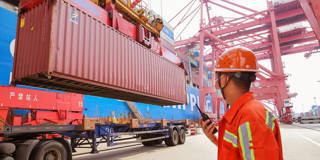While exports from the European Union and the United Kingdom to Russia have plummeted since the Ukraine war began, exports from the EU and the UK to Armenia, Kazakhstan, and Kyrgyzstan have increased sharply. This suggests that sanctions are working, but far from perfectly.
LONDON – Changes to the global trade system, not least because of the deepening Sino-American rivalry, have been making headlines in recent years. Yet while most of the attention has focused on trends like “friend-shoring,” “near-shoring,” and “reshoring” of supply chains, recent changes in the patterns of cross-border Eurasian trade have gone largely unnoticed, despite their implications about the effectiveness of Western sanctions on Russia.

LONDON – Changes to the global trade system, not least because of the deepening Sino-American rivalry, have been making headlines in recent years. Yet while most of the attention has focused on trends like “friend-shoring,” “near-shoring,” and “reshoring” of supply chains, recent changes in the patterns of cross-border Eurasian trade have gone largely unnoticed, despite their implications about the effectiveness of Western sanctions on Russia.